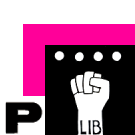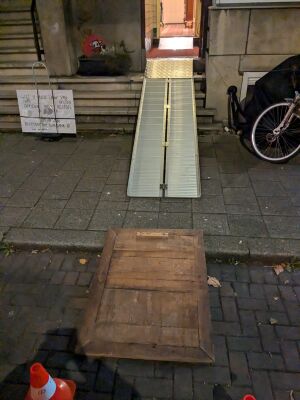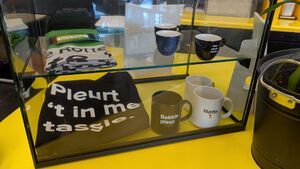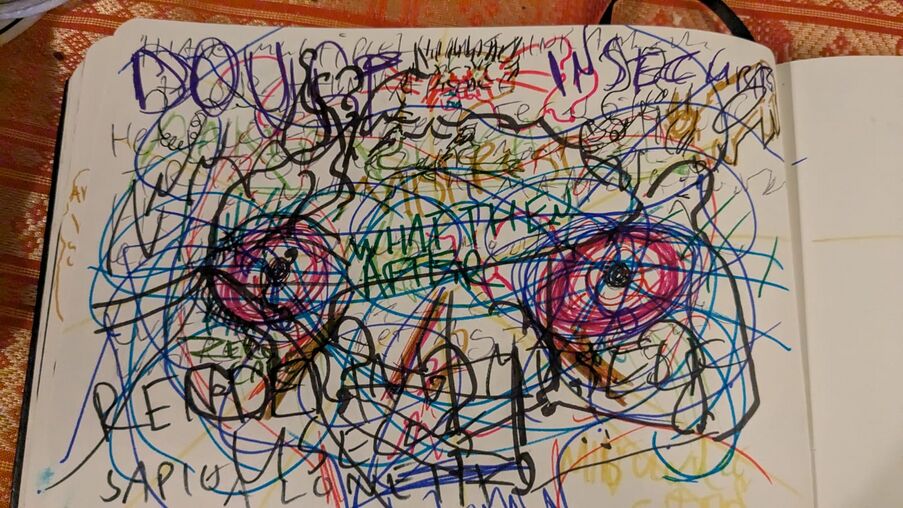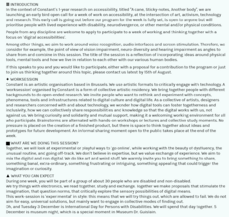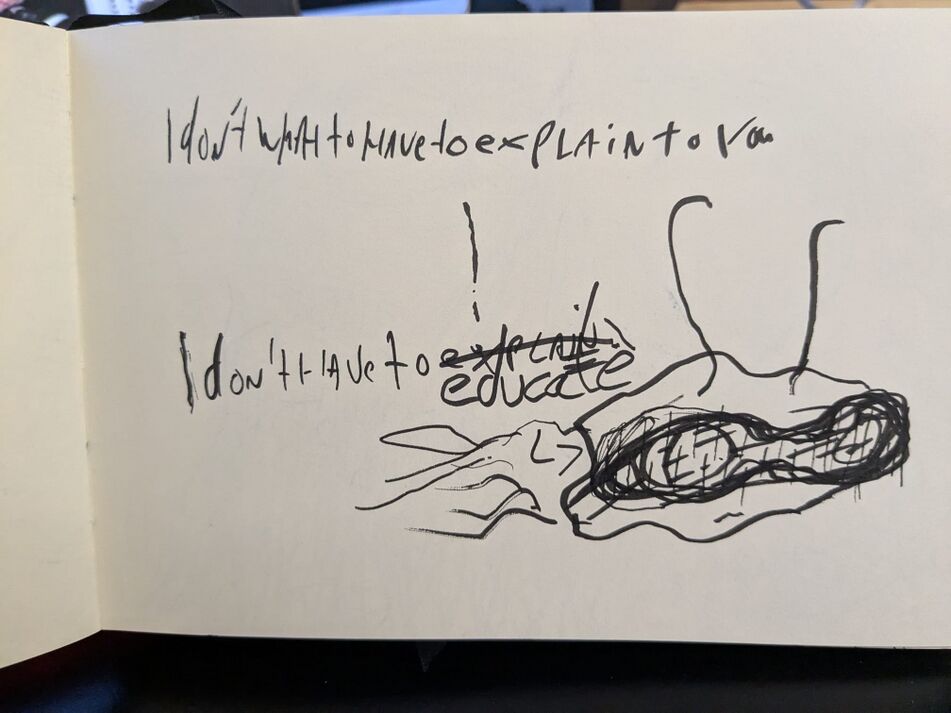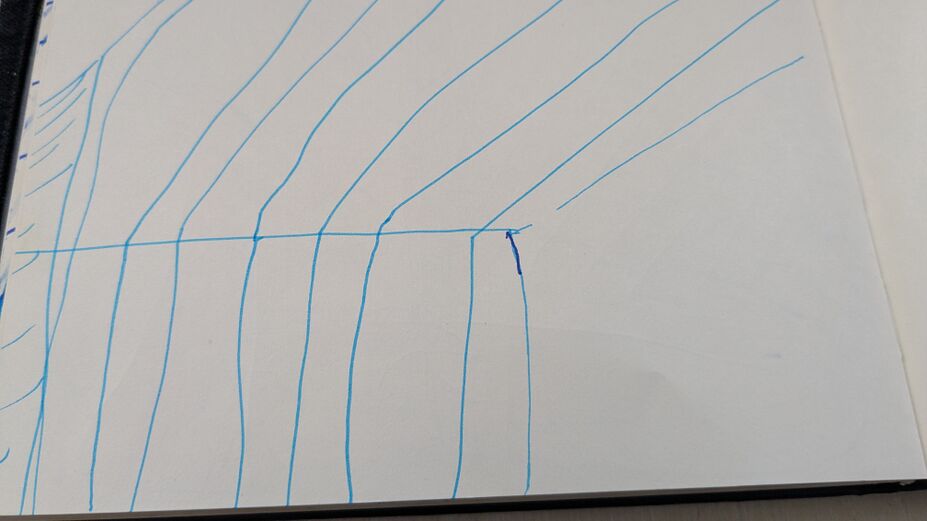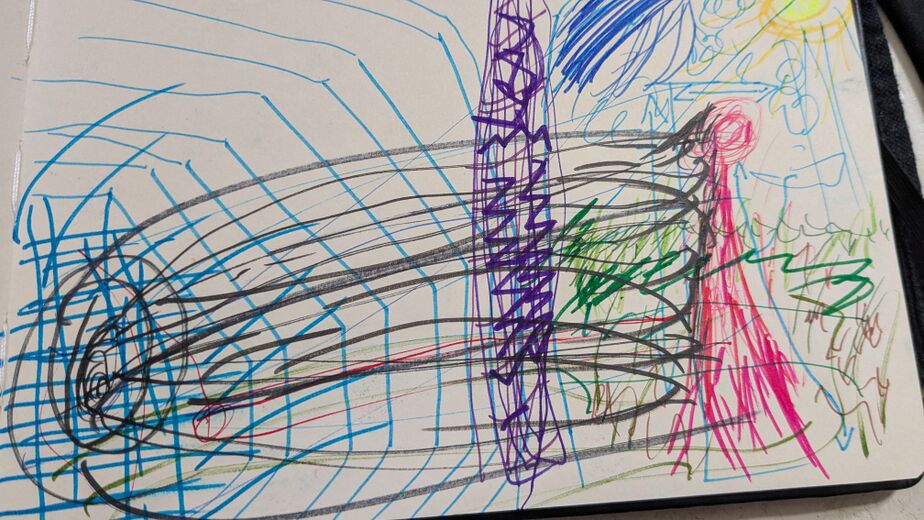User:Lor.ensō/contextures
Perfect timing! I suggested edits here:LorenzoThesisDraftSteveSuggests, Lor.ensoDraftSteveSuggestsLatest (March fourth) suggestions LorenzoThesisDraftMarch4suggestions 13March Lor.ensSteveSuggestsMarch 13
Contextures, a thesis by Lorenzo Quint
Thesis submitted to: Piet Zwart Institute, Willem de Kooning Academy, in partial fulfilment of the requirements for the final examination for the degree of:
Master of Arts in Fine Art & Design: Experimental Publishing (XPUB).
Adviser: Steve Rushton
Second Reader: Marloes de Valk
Word count: [approx 8000~ something (mar 14)]
Introduction
*The thesis comprises a series of chapters*
*Each chapter comprises annotations of a drawing*
*Each drawing focuses on one (or two or sometimes even more) of these aspects related to accessibility:*
Traveling around the city of Rotterdam with my brother, who is in a wheelchair, has made me aware of the architectural, cultural and bureaucratic limits that define our movements. In this Thesis I will reflect upon, (de)construct and criticize Rotterdam. I will reflect on Rotterdam in contrast to the utopian postcard realities that I experience in the city. In this text called Contextures, I develop a "counter-mapping" [1] practice in relation to the issue of accessibility in Rotterdam. This will take the form of the transcription of a series of drawings which I made whilst writing Contextures. I will also use my knowledge and experience in world building with 3D software. [2]
The text will be structured by the following themes, each of which represents one of the multiple obstacles to getting around.
Socially - Personal, Affordable, Family, Housing
Accessibly - Disability, Information provision, infrastructures
Bureaucratically - Protocols of local municipal / governments
Architecturally - Buildings, ways, pavements, roads, streets
Virtually - Imagery, impression, media, softwares, simulation, games
Culturally - budget cuts, false iconism, counterculture, grassroots, community, festivals/gigs/events
Before I will talk about situations, locations and access, I will pinpoint my own relation to my findings. Consider this a small biography relating to me and my close family in order to understand the Contextures:
I am born and raised in Rotterdam. I have lived in the North/Centre of Rotterdam for my entire life. Which is convenient because of the multiple ways to get around to places. I have been diagnosed at an early age with Asthma, PDDNOS(now best known as the ../other folder of the Autism Spectrum)[3], ADHD & SOTOS Syndrome[4].
The latter had an effect on my balance organ and because of that I can't practice my Dutchness in riding a bicycle. Which is also answer to the frequently asked question: "Huh? You can't ride a bicycle?" which is then followed up by "I thought everyone in the Netherlands could ride a bicycle!".
These diagnoses put me in a position in early life that is called 'special'. We have 'special education' which basically means your education is based on or around your specialty (or without sugarcoating: your disease/disorders). Special, to me, is a sort of stigma that already excludes to a norm instead of explaining that something needs close attention in order to 'properly function'.
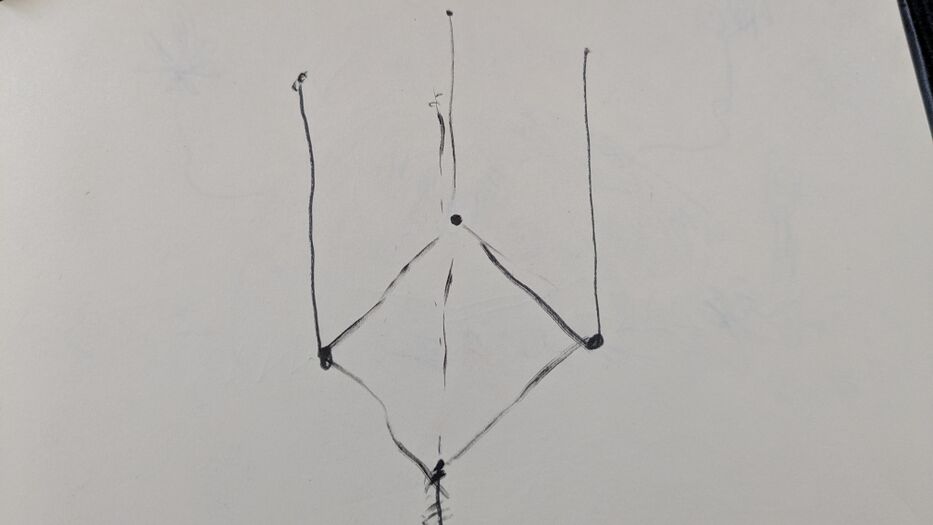
↵My father (1957-2023) has worked in the government as employee/staff/advisor/head of IT all in the sense of ministries considering information provision. My father would have gone into retirement in November 2023. In the Summer of 2023 he had excruciating back pain to what we thought might be related to age, he was referred to physical specialists/therapists but when he went for a scan in hospital and in the end of September 2023, it turned out to be metastatic cancer in such a state that even extending his live through new innovative techniques would not provide him of the retired live he deserved: Often cycle around to do chores, reading and sometimes go out for entertainment or food, whilst being together with us. He truly was the pillar of strength in our family. And also in the sense of having a car, driving us around (mostly for my brother and mother).In the beginning of October, he passed away after a short but intense time of illness. This was around the beginning of my studies at Experimental Publishing.
↵Since 2016, my mother has a medical condition. She has a stoma [5] damaged/stitched colons. She is dependent of medical appliances such as olimel [6]and water next to a stoma. She also sometimes need medical attention; she needs to go to a hospital for check ups. I function as some sort of part time caretaker/giver, mantelzorger, in times when instances fail but also just in general to help out. My mother has a mobility scooter for she can't walk long distances.
↵Since 2019, my brother has non-congenital brain injury. He can not stand, walk so he is either sitting or laying. He has an electric wheelchair and a mobility scooter. He lives in a facility where he has his own house but where gets medication to support him in his condition and to help him in and out of bed, wash him, etc. Next to those needs he can move independently.
All the beforementioned things considered, disability mobility, accessibility and such are huge part of my life. Before XPUB, my previous graduation work; Happytalism[7] was a critique on wellness / new age / spirituality which revealed to be harmful during the COVID pandemic. In my thesis A Guide To Nether-Hell : A Journey Through Depiction & Experience From A Nether-Divergent Perspective, I describe the damage of enforcing normalcy in relation accessibility and disable, but also the idea of an alternative in sense of subculture and community. [8]
As my father passed away at the beginning of my time at XPUB, I / we went through a shift in family dynamics and we had to make a lot of changes in our lives. As I don't have a driver's license. My brother needed to apply for Social Taxi in relation to his inabilities. My mother needed to apply for the same but a different service and also for domestic help. In one of the following chapters I will go into details about the steps that were needed taken.
In this progress I try to help, yet being aware of my own autonomy. The situation has changed and we are slowly but steadily trying to the make the best of it. Being in this process clearly influences my study at XPUB in the sense of prototyping, learning about methodology (i.e. structurelessness, nudging) that relates to nether-hell & happytalism.
As I have learned these new ways of looking and working, I used these lenses to look the things I encountered while adjusting to our new 'normal'. Whilst being in the reality of dealing with changes in relation to our new way of living, I see that the city where I'm living is showing itself in new ways and that everything is going in a peculiar direction of a perfect slickly rendered city that only shows the promise within the demolishing confines of innovative visions. In reaction to these developments, I started developing my counteraction of ↵ConTextures: a portmanteau of the following words** And from these points of view I tend to look at the contextures.
ConTextures are a portmanteau of the following words**
Con = "an instance of [deceiving] or [tricking] someone. / [persuade](someone) to do or believe something by lying to them." (CITE) Context "the circumstances that form the setting for an event, statement, or idea, and in terms of which it can be fully understood." (CITE) Textures "Texture is the physical feel of something — smooth, rough, fuzzy, slimy, and lots of textures something in between. Sandpaper is very rough — it has a gritty, rough texture. Other things, like linoleum, have a smooth texture. Texture has to do with how an object feels and its ingredients."(CITE)
Contextures is how I see the modern Rotterdam renders and promises. The rendered textures do not calculate, the context of the city. It's a deception and a false promise that sends out a city sentiment outwards to new potential buyers, visitors and inhabitants. Of course, there is no trust found in the realtor, concerning artist impressions postcard surrealities that is put before the wasteland on which the new building is currently emerging. In the following chapters, I attempt to zoom in on my findings and zoom out towards a bigger picture and then go back again into how things work on floor level and in these intense zooms.
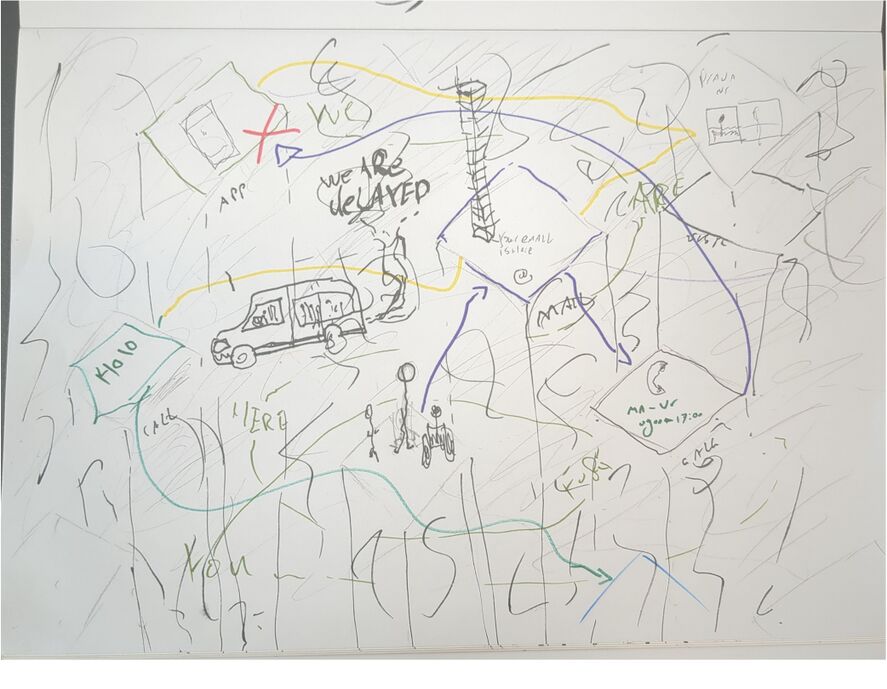
These issues become invisible. When people do not see them. they do not exist.
DRAWING_1/GET AROUND/ Socially - Accessibly - Bureaucratically / (un)Familiar barriers, social thresholds and unmeant ignorance
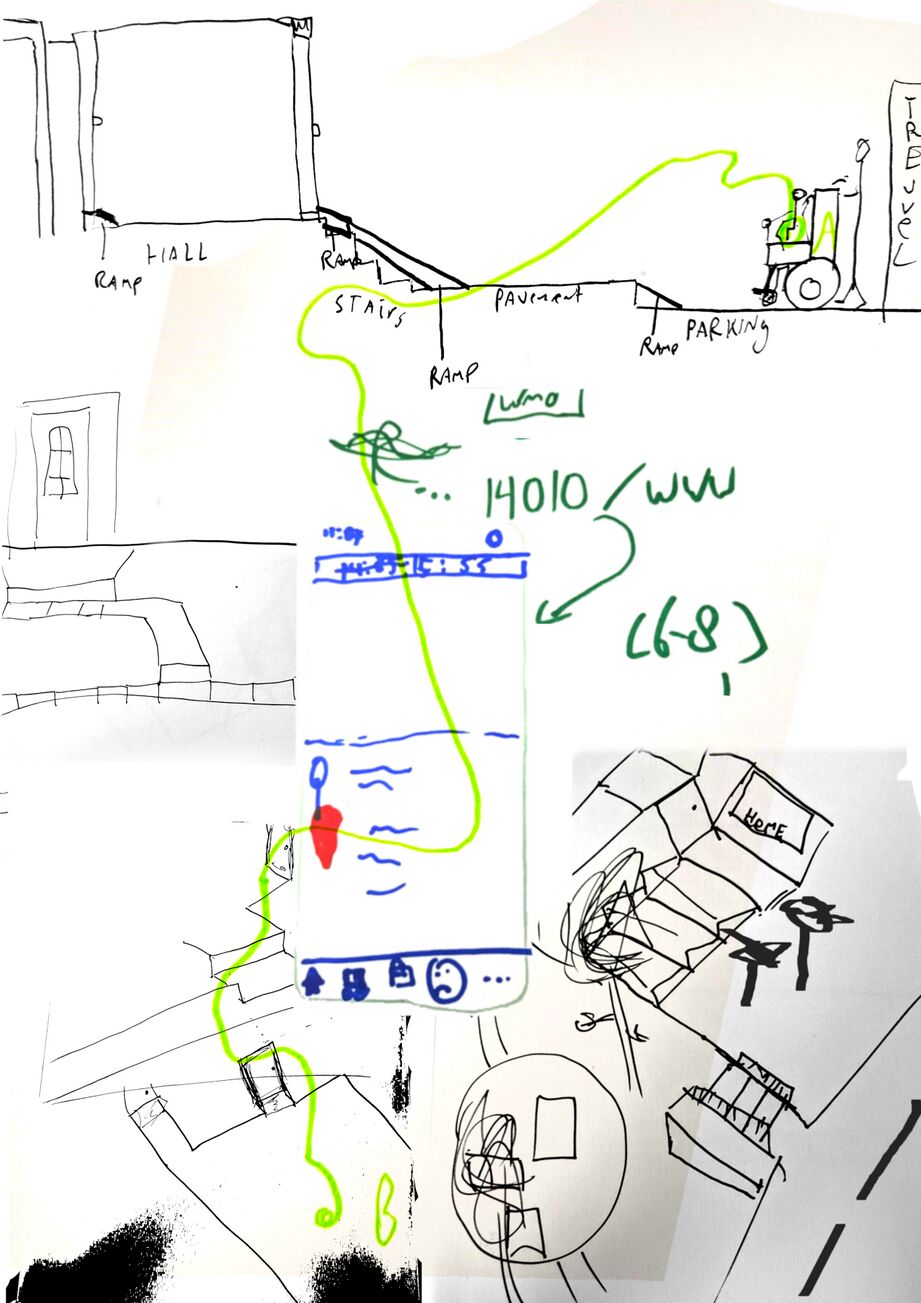
In the top right, it is me pushing my brother from street level, to pavement, over the ramp inside onward towards inside.
Below the hall there is a front door view of where my aunt and uncle live. Which is a multi-threshold construction of tiles, bricks and pavements, resulting into a tight door which isn't wide enough to fit my brothers wheelchair into.
In the middle of the image. Is a sketched version of the Trevvel app-interface based on the ride booking/reservation screen. Above this screen is a sketch of the Gemeente logo with the word of WMO (law for societal support) and the number 6-8, indicating the weeks it can take before you know if you qualify for Trevvel.
On the right side of the interface. A sketch based on the front door situation of my Nephew's recently bought house. (Looked at above from Google Earth) Where we met up to meet his kid and showing us through the house. My brother couldn't get in because of, once again construction of tiles, bricks and pavements. With another social threshold that could have been helped, had we the knowledge of entrance, since we do have ramps to get past this. Wouldn't know if he would fit inside, though.
On the bottom left, there is the possibility of a back door of my aunt/uncle's place. Which we didn't use in the end.
The A to B line in bright green hovers over the different thresholds. To show what bizarre detours have to be done to get complete the route, not even mentioning the delays.
Socially - Accessibly / (un)Familiar barriers, social thresholds and unmeant ignorance
In this chapter I aim to show the preconceptions that are often there about the multiple obstacles to and how these become invisible when people are unaware. When people do not see it. It does not exist.
I am zooming in from the big picture to a personal experience. The questions I'm currently asking is:
How does one Manoeuvre [9] or get around 'town'?
Starting with myself: I can not ride a bike, so I either walk, take public transport, take a cab or carpool with someone. My brother can not walk, he is in a wheelchair or mobility scooter, so public transport mostly isn't an option. He can be transported from bed to wheelchair, from bed to mobility scooter, from wheelchair to a car.[10]
It is mostly the case he gets around with something that is called Trevvel[11] He manoeuvers around in his mobility scooter for longer distances and for shorter distances, he uses his electric wheelchair. One would assume that this fixes a lot of problems, which is true but still he meets a lot of obstacles on the way.
Here's an example of a difficulty I encountered. I intended to go to a friends Halloween party. I needed to get there via metro and bus. I couldn't stay there, and the option of a taxi with a big group was too expensive. Another friend offered a place to stay, but that was only accessible via bike. I didn't go in the end, but that kinda struck to me. This wasn't the end of the world, just a bit shitty and I felt a bit left out, even if this was well intended.
The frustration I felt through being presented with a series of comparatively low thresholds made me consider my brother. The thresholds that occur along the way for him: from a pavement without hills or ramps, to bureaucratic, social and architectural thresholds are of a different order.
Here's an example of a difficulty my brother encountered. My aunt wanted to plan my grandfather's birthday at their place in Spijkenisse, but they were worried that my brother can't access the hallway, because it is too small and the chair might damage the varnish. The other option was that he comes in through the backdoor but that was also inaccessible due to the same compact measures and fear of damage.
My mother came with the idea that we would do it at 'our place'. Which means I have to 'work' for this: I sometimes help my mother as a Mantelzorger. [ informal caregiver ].[12]
Every 4-6 weeks, my brother, mother and I have a little get together. Because, if I want to meet with my brother and mother at my mother's place, it takes some preparation:
The mobility scooter is too heavy for the ramp, he needs to get there in a wheelchair.
For my brother to enter my mother's house, we need*:
- to reserve the parking spot before the pavement by addressing neighbours, people on the street. [13]
- to place a hill or a plank on an empty parking spot
- to place a plank/hill from the street to the curb
- to place a ramp from the curb that which transitions into another a hill(small ramp) going into the hallway
- to place another small ramp in the corridor to enter the entrance hall.
*The ramp and hills needed to be purchased.
- The ramp and hills need to be stored.
Quite the protocol on its own with these steps to make.
My brother has multiple ways to manoeuvre around, which gives him freedom. To get these things, there's a process that has to happen via the municipality. For this, he needs to get the 'social' version of Trevvel [11], called Trevvel Samen'.[14] Applying for this takes 6-8 weeks [15] and is done through the Gemeente via communicative layers of bureaucracy.[16]
You would say this system would be great, customized for the person. The wonderful idea of social transport and traveling together and having a customized travel based on your necessities. But it has been quite the 'ride' so to say. Concerning my brother and mother. It either can go well and as it should be.
But when requesting a ride, you can reserve a booking via the app or call the company. It just works like a regular taxi service. It gets communicated via some sort of telecommunication device :
## \\\\\\\\\\\\\\\\\\\\\\\\\\\\\"I'mavailable"\\\\\\\\\\\\\\\\\\\\\\\\\\\\\\\\\\\\\\\\\\\\\\\\\\\\\\\\\\\\\\\\\\\\\\\\\\\\\\\\\\\\\\\\\\\\\\\\\\\\\\\\\\\\\\ ## //////"We have a ride from Boermarke 65 to Statenweg 127a" ////////////////////////////////////////// ## \\\\\\\\\\\\\\\\\\\\\\\\\\\\\\\\\\\\\\\\\\\\\'Yes I will take that one'\\\\\\\\\\\\\\\\\\\\\\\\\\\\\\\\\\\\\\\\\\/////////////"Okay"///////////////////////
My brother then communicates that he has a ride planned. He sends us a message and we set up the small and large ramps. We tip the driver based on the fact if they help, are friendly, cooperate and participate.
There are a few social factors and flaws in dealing with these procedures. Not only from services but also to close relatives:
In the spring of 2024 We wanted to book a ride that picks up my mother and me(Blijdorp area) and then also picks up my brother(Crooswijk area) That wasn't possible, because there has to be an hour between rides.
So we, in that matter, needed to be picked up and brought to my brother. And then we would join him on the same ride. We then decided to go separate and ended up being picked up in the same bus.
This ride was heading to my nephew's house.(Spijkenisse Area). We would visit and look at his new house, meet his newborn son. Planning these visits require alot of practicalities. The family we were visiting, did not think about my brother's situation. Unintentionally ignorant, the relatives we were visiting, did not realize that my broither can not access my nephews house for there are concrete tile stairs and a very narrow hallway. Making the house a liminal space to my brother. This is highly upsetting because it raises an idea that when one lives in the vinex [17]type lifestyle arrangements of normality. Where the tunnel vision of their own living, does not even consider our contexts in order to facilitate a visit. As Spijkenisse is a new town(Siegel), it has a lot of vinexwijken with a nuclear family type of normality. A modern village in this Truman Show type of aesthetic, where the norms differentiate when you start living in these peculiarly over designed area. Even though my nephew is a sweetheart and does not have any bad intentions, it was truly striking that it did not come to mind to him nor the other relatives that my brother has been impaired since 2019. We were lucky that the weather was nice and the day turned out to be a nice day with our relatives. The fact of this unaware behaviour is concerning. I mean, just imagine a rainy day in this context?
The day ended, as our(me, mother) ride was there according to schedule. My brother had a different ride, that took so long that he was picked up the moment we arrived at my mothers place. Resulting him to finally be home an hour later than us.
Another familiar example, towards the next organisational madness: organizing my grandfathers 89th birthday.
Objective: my grandfather wanted to celebrate his birthday at my uncle and aunts place in Spijkenisse. We needed to see what the possibilities were in sense of front/back door situations as shown in the drawing. A lot of planning, measuring, communication needed to be done.
Our best solution was the three of us. went to my grandfather for _a custom_ version of his birthday. My mother and me were picked up around 13:00. My brother was in another bus and the driver picked up other people, so it took him longer to arrive. Unfortunately for our logistics, the Spijkenisse bridge was under construction, which redirected traffic. Meaning my brother be there 1,5 hour (!!!) later than us. Returning, we three were scheduled to leave 16:45, but we had to wait an hour to be picked up. My brother started to get tremors (myoclonus) because he didn't have his medicine (we assumed he was going to be home in time).
The ride back was bizarre as the driver picked up people in another location, and just before we reached my brother's house, they picked up another person at the Saint Francis Hospital (SFG) in Rotterdam. My brother was not doing well, getting pissed off and tired, which was influenced by / influencing his 'shaking'. When we were finally were heading to his home in Crooswijk. The last picked up person squished herself out of the bus when we were almost at our own space. Whilst we could have also requested the same but chose to be less egotistical.
The last familiar meeting was Christmas brunch, where social and logistical struggles continued to new limiting thresholds and even lower deeper valleys. We planned a Dunch with my grandfather. My grandfather around was there at 14:30hr and my brother was supposed to be there at 15:00hrs. Due to the organisational clusterfuck at Trevvel, my brother arrived there around 17:00hr. Not only did my brother have to wait in a very insecure manner, at the same time, his wheelchair was having some technical difficulties, which lead to me pushing him up the ramp with x3,5 strength because of a double brake effect as a result of to handles being stuck, that weren't supposed to cross.
But then of course, the bus was there too early for the ride back. My brother was heated with anger and said he wanted to finish his dinner and that he would call for a new ride.
These are a few of the many stories of how customized so called "social" transport, still has plenty of drivers and systems that are not listening to the needs of the travelers. And the fact that people need to wait 6-8 weeks depending on their situation if they qualify for this?! My brother in this case ends up less healthy and supported than this Social Support Law and Customized Transport.
This is story exemplifies the degree of mental and physical preparation required to move through the city. There are MANY day-to-day transactions that require understanding and knowledge; it requires a municipal threshold; it requires physical support and aftercare and rest afterwards.
There are multiple obstacles to getting around, socially, accessibly, bureaucratically, architecturally, virtually. And these become invisible when people do not see this. When people do not see it, it does not exist.
/DRAWINGS TWO&THREE/Virtually - Architecturally - ..culturally?/ Innovation and Virtual Tools as development or demolition of reality
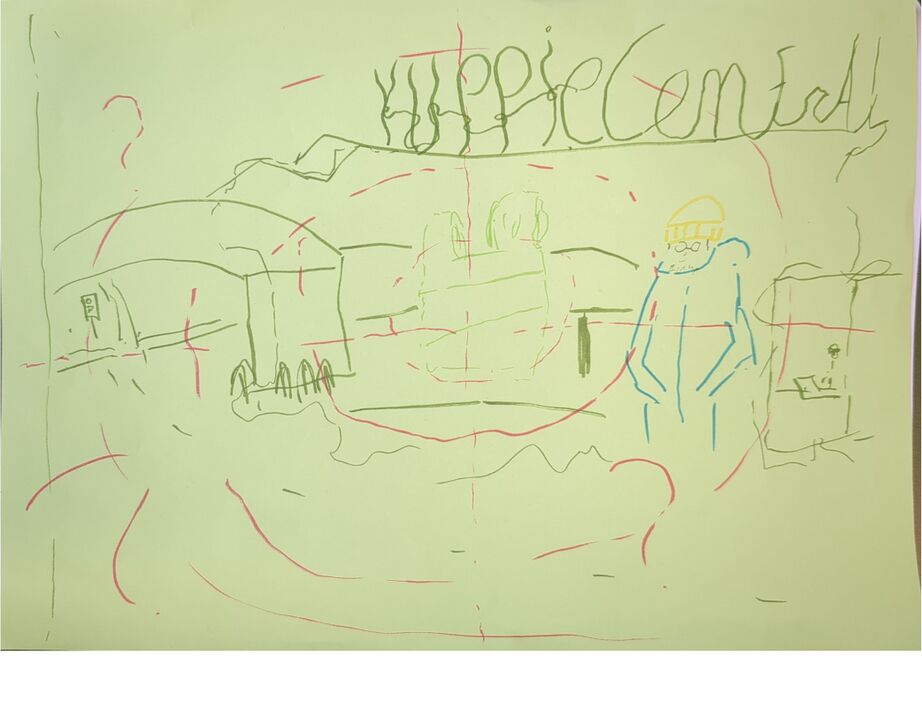
I see the stereotype of how a yuppy or hipster looks like, claiming a space or a stage in the theater of the street. Inside the coffeeplace/bicycle repairshop. There are always people catching up and working, and there is nothing wrong with that. I do not have strong emotions against local facilities. However, I do tend to think aggressively when I do my groceries at the local mall that is next to this new hotspot.
When I walk there see people drinking coffee, and getting their bikes fixed. Combining that with the recently opened Station Bergweg[18], gives me a double feeling. The Eudokia square, is a local space where multiple groups of people meet or hang out, but also with their contexts, waiting for the local municipal building. I feel a certain barrier or gray area in that harsh location. And it feels like these new hotspots rather distract mask than improve it. These facilities potentially brighten up the area, but what do they offer to their location? My mother lives in Blijdorp and since 2014 there is a pizzabakery next to her place, which is truly an amazing group of semi-neighbours. At the end of the street, there Sajoer, which is a hip coffee/juice place that generates a certain 'gezellig' atmosphere on the street but also invades the street in relation to the people living in there. There is again the paradox of a meeting place that also expresses a certain disregard.
As I walk at the Berwebg in a very bad mood, I sometimes feel like aiming my mental target as an offense to what I call SusanBij(l)olence. As this portrays a certain socialite/urbanite elitist 'look how culturally I am' and I think this is the core of my 'being a Rotterdammer' which gets salty. There is an ice cold 'niet lullen maar poetsen' / 'opgestropte mouwen'-mentality which is part of the local identity and I think in the GeoPsychological matter that this then gets opposing towards 'Aanstellerij'. And this attitude is something that is a reaction to what seems to be eternal inaffordability and how this city is developing. But is it developing?
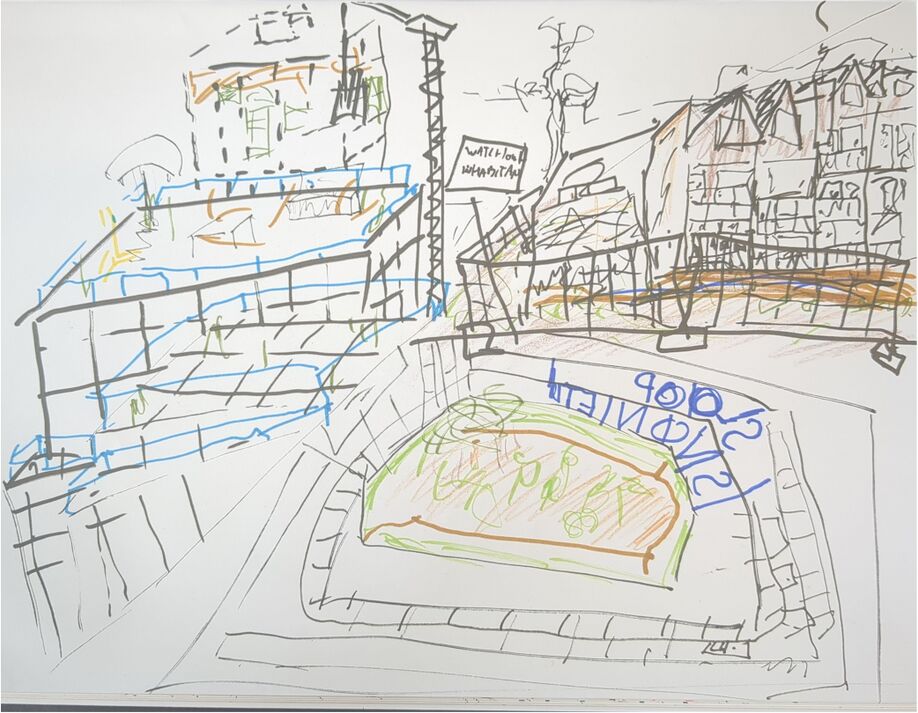
On the left, the tower is emerging from the post office next to the City Hall. I see it when I walk to the academy and back and it gives me the 'live feed' feeling that architecture is being rendered. Under this building, the top surfaces of the Timmerhuis is visible. Which is a modern apartment complex that also 'gives shelter' to a brewery, museum Rotterdam and municipal services offices. It is quite typical that these are together, because in the Timmerhuis, the municipal office of VONK (the Innovation Center of the Municipality of Rotterdam) is located.
On the right is a portrait of the remains of the Tweebosbuurt (South of Rotterdam) with a sign next to it saying: WATCH OUT, INHABITANTS. This location carries the history of the social housing demolition and is currently being held up by the last inhabitants who are refusing to leave because of the poor conditions and unfair compensation of their next housing.
The drawning on the bottom is the inside of the Pompenburgflat. which spells SLOOP ONS NIET (DON'T DEMOLISH US). Havensteder is planning on breaking down this building to put three new living towers there. https://rechtopdestad.nl/beter-ten-halve-gekeerd-dan-ten-hele-gedwaald/
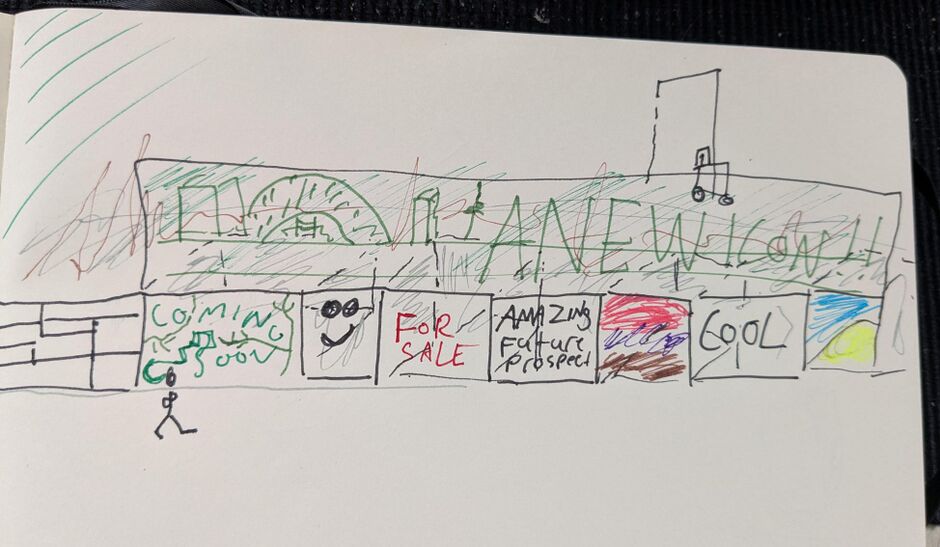
In this drawing I print my idea that in general this city planning of living, shopping space refer to a future that does not exist. Of course the paradise-like garden that currently becoming reality from the render of the Hofplein fountain is something that makes sense, more pedestrian space, less violent traffic. But just thinking about all those new skyscrapers and other buildings that are possessed by people and it's eternally for ´rent´ as if it´s affordable. So it remains an empty site with the same hollow insides as the 3D rendered software it designed.
Continuing on the ridiculous rendered fantasy, I imagine that at some points the liminal empty spaces will be covered by a masking AI generated render image that will remain 'flat' and is only to be entered via subscribed virtual surreality. Because that is exactly what I see when I walk past the artist impressions printed on wooden structures promising the new icons. It is around ten years ago that the previous icon was there to promise a new kind of shopping experience in Rotterdam. De Markthal opened up and promised to change the living and shopping experience. People signed up for the ideal price of looking over the famous Binnenrotte and Hoogstraat.
The same Hoogstraat will be hidden behind the new icon 'Rotta Nova' and so the same people can now look at another building. And regarding the promise of the Markthal, the actual people that work on the market had to accustom to these plans with the promise of that they would get some spaces of the markthal. SURPRISE! They didn't. The Markthal is now mainly a tourist attraction or a shopping mall for very specific niche kinds of cuisine. The only Market-part of this hall is that it is a fancy food spot near the actual marketplace.
In the same year when the Markthal opened. Rotterdam made the 5th position in the Lonely Planet cool city list. Since then, the general opinion of Rotterdam changed. About 20 years ago, Rotterdam had what was called the second city syndrome. People spoke about Rotterdam with disgust about its filthy air, the amount of crime (which was just covering up racist remarks) and the idea of the city was changed. And that is exactly where I think is the core of the issues with this new 'vision' of Making It Happen. Rotterdam's former motto is Sterker door Strijd. (Stronger through battle). The 'rawness' of this line dates back post-WWII, when Queen Wilhelmina gave this slogan to the city as it was struggling during (and post-)WWII.[21] The mentality of re-developing the city goes along the 'niet lullen maar poetsen' I mentioned in my anti-yuppy rant, next to that the nickname of 'cockroaches' which Feyenoord football fans are given since they supposedly survive wars. It also makes me think about this song by Jaap Valkhoff. Where he sings about the modern city developments of how rapidly it develops. (1955) [22] This is resonates with deceased jazz musician and city poet, Jules Deelder's Rotown Magic. [23] I'm well aware of the fact that both of these things are of a different time, yet there is a certain pride and rationality in these thoughts that bleed through the modern toxic positivity in the city branding. When I speak about disability and accessibility struggles and trying to get help with the gemeente. There's a painful recognition coming in that reaches a big scepsis / cynicism which then again rhymes with the former (self)-images. I don't want to speak for 'we' because I'm just representing my surroundings, however, even if we want to be happy for how 'well' its going in the city, there are still multiple visions of how Rotterdam branding is selling itself to the outside world whilst still remaining the Crack City. In 2016, Michael Schaap, released the final series of the 'hokjesman'. series where he acts as anthropologist, asking questions and looking at what a 'Rotterdammer' is. [24] Looking at all the cultural history and also with infights.
In search of ideas considering Renderdam [25] I bumped into Jesse Siegels' Default Alpha. [26] Where he discusses walking around in synthetic hybrid culture, the concepts of -new towns, eco- and garden cities and digital psychogeography. The idea of a New Town. In *synthetic hybrid culture*(bla bla harvard', he speaks about the campaigns of newtowns through advertisements in a standardized format, reflecting on concerns of the greater population.
He names Stevenage(UK, 1959) and Lelystad(NL, 1967) as "preservers of the Nuclear Family*" Promises the ease of grocery shopping for housewives and how working men could bring bread to the table. In a modern city like Rotterdam during the housing crisis, in this contemporary day and age. It is truly bizarre that housing is customized for families. Single people or people in modern relationships are bound to either conform to something. Same thing goes for people that earn too much or too little and then practice the art of 'scheef wonen' so that they live somewhere above or below their paygrade and then also get looked at for doing that.
Siegel mentions the modern townsphere, where the presentation isn't towards the *people* as it is towards the investors. Promising the resolution of climate change, traffic, overcrowding and making the new town, the new standard.
And the promises then come from both the investors & planners. Rendering its ideals on techonologically advanced atro-cities i.e. United Arab Emirates. Showing these promises in ambitious videos that slightly visually change /manipulate the environments. At the origin of New Towns, the visuals had to be fully shown in original form, whereas now the vision relies on stock footage and 3D architectural renderings with the promises of a futuristic living space that still is infused with heteronormative views. In the *GARDEN CITIES / NEW TOWNS / ECO-CITIES* , Siegel refers to the idea of a Garden City being the *perfect* combination of country and town. Bringing the excitement of a city and blending it with the peace of a rural environment. Reflecting on Sir Ebenezer-Howard´s three magnets of town, country and town-country and how the 3D architects take the magnets along in the biotopian renders.
Another source, I generously got from my current academic bubble, is Smooth City by Rene Boer[27] n Smooth City, Rene Boer talks about smoothening as an universal contemporary topic of hiding anything that isn´t smooth, in Dutch we would say 'glad' or 'gelikt' (licked). Smoothening impacts peoples access (Rotterdam makes new Kralingen https://nieuwkralingen.nl/project-nieuw-kralingen/), it focuses on outward appearance and anything that is irregular is damaging the image. (from the KOZP and woonprotest to anti-loitering measures). Around 15-20 years ago, as Rotterdam is never done[cite]. There were former version of planks covering up the wasteland of the new city station: # ‘Hoor, hier bonkt het nieuwe hart van Rotterdam’ *Listen to the new heartbeat of the city* [1]. The promises of the new city (in relation to the New Town ;)) had the word *Vibrant* (bruisend). 'Just like other big cities where you can do anything and the city is always open', Amsterdam has this appeal of a big nightlife and that is also what I understood in this idea of bruisend. The entire idea of Rotterdam Making It Happen and becoming a DO-RIST (active tourist) videos revolve around an entirely waxed clean version towards the outside. The Toxic Posivity of Cool New Innovation in the city is projecting aggression on the people that are desperate for housing and as 'we' are still on the list of one of the largest poverty rates in the Netherlands. As Boers talks about no space for alternative narrative in the demolition of the public domain to private property. Frowning and looking down upon this modernities is not accepted by anyone that falls into the trap of the promise. Around november 2024, when my project Contextures was in a pre(word) state, a talk that I had with a visitor of the public moment was striking: 'This is simply what happens when you want to live in a big city.' And I understand the appeal of this argument, however, that is a smoothening argument that accepts the decay of what it means to think about to who a city belongs. Boers also mentions 'outright exclusion, fenced off festivals' (p 53) which resembles the festival policy that happened when in 2009 the Hoek van Holland beach riots [2] were dangerous and also when a stabbing Bevrijdingsfestival 2009 caused a violent atmosphere. Out of safety precautions, former mayor Ahmed Aboutaleb sharpened policies and a year later, most festivals were fenced off out of safety measures. Smoothening out the crime but also implementing a new norm which closes off (cultural/culinary) activities from a public to a private space. There is a common idea that the city / gemeente doesn't listen to its citizens, inhabitants and fully focuses on the outside. Neglecting fragility, privatizing social housing in allowing (inter)national investors to buy up housing. Boers (p 54) speaks up about affordance in conformity and internalizing new norms. Which not only means smoothening away the critique, but also means accepting ideas of the places where you live. Adapting (to) the rendered visual and becoming the person in the seamless artist impression. Is there room for public needs? The only way I can now think of is the local folders that invite people to talk about the neighbourhoods. But in the same idea, de Luchtsingel (yellow air bridge) was made years ago with (former National Poet) Ramsey Nasr's great poem Mi Have Een Droom, which takes place in a Rotterdam in 2059. Where the languages of Rotterdam's inhabitants are blended into one universal dialect. [3] As the poem remains, most of the luchtsingel needed to be broken down because the bridge was dilipidating. To me, the displacement of this connecting bridge is poetic in a melancholic sense because this was a project that was made as a citizen initiative. Boers mentions the relation of blackbox(dynamic that is that known for what it does but not how it works) and how smoothening of a city pushing away disabled people from the drawing table. My personal example in this case (and also what I hear from my best friend), that it is incredibly difficult to change a pavement in relation to accessibility. In order to do that, you need to, again, apply for it. This takes **time to process.** Requesting a talk with Rotterdam Social Act. Then it depends on the talk because this person needs to hear the case. Then it depends if this is for this 'desk' of the gemeente to call. Concerning all smoothness and development, it should be the main reason that it is beneficial for all and not just the people at the right side of the 'edge' where raw and smooths ends meet. Renderdam in this case, is a place where no poverty, inaccessibility and other things exists. Tis but a framing in the selling point. But 'we're not buying it'. Not only because of its inaffordance but also the commodification of the Rotterdam stereotypes that is put into de Koopgoot and also on the package that are sold in i.e. deWillem. To finish this rant on Rotterdam identity. The idea of the instagrammable appeal of the city is something I never felt at ease with. The hip urban aanstellerij is a view that is the cutting edge between multiple identities of the city. Of course it may co-exist. But what is it more, than standing in the way of people that actually make it happen, than only standing in the picture perfect idea of making it happen. The co-existence of the emerging 'high culture'/ yupperclass and the chauvinist [28]that has become a selling point of a karikature compilation of either Deelder / Pan Bami / the typical accent and finding it cool to have it on a shirt or a mug. To me both the mug with bakkie pleur and the susan bijl bag can just function as bugs but not as identity sellers.
Note: there's a half year between the actual applying for this. in relation to the thing that we want to 'make happen---- [process time text]
Near Rotterdam, towards i.e. the islands of Voorne Putten, there are new towns with nuclear family ideology. My family from there has certain standards that strike in their reality but my reality would break the confines of their environments.
DRAWING4-11/Chapter[seeking for support]? CULTURALLY / SOCIALLY /

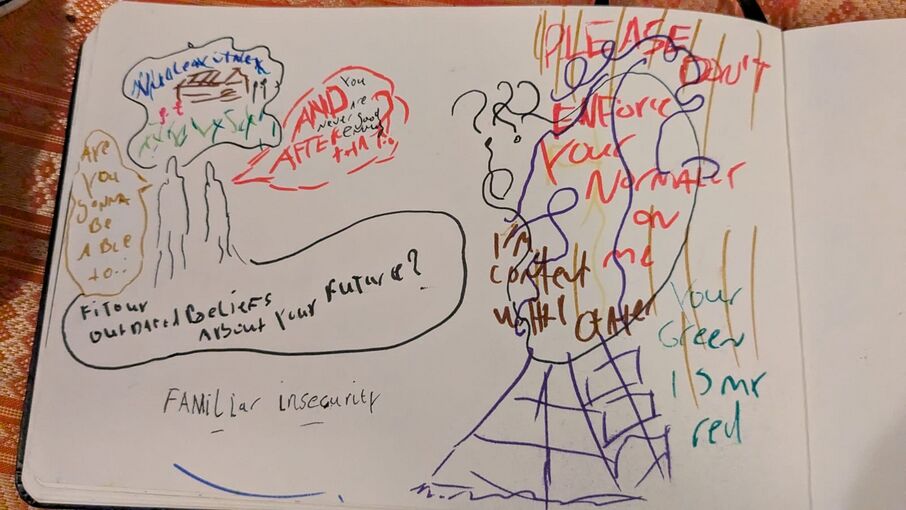
Martino Morandi suggested me to participate in Constants A cane, sticky notes, another body work session in the beginning of December 2024. The description got me excited for this amazing experience of new insights, As I am fully immersed into the subject of (in)access, (in)affordability and (dis)ability. The week chronologically consisted of Introduction rounds, overviews and logistics. There was an artist presentation about works concerning ableism.(Cripping the Space, Engagement Arts; compressed interviews on ableist experiences called Testimonies)/ privilege checklist and tools (some sort of manifesto in the shape of a checklist)
On this checklist, there was a questionable bulletpoint: Ik hoef bezoekers of personeel niet te onderrichten over structureel validisme. (I don't have to educate other people about structural valid-ism)
I raised both my question and my eyebrows, asking "how do you bridge the gap of knowledge then?" in which they responded in a matter of that they should be some sort of disability advisor and they don't do this for free.
After that, the day was concluded without the artist because they had to leave earlier.. And in the evaluation of the day. Complaints were made about their presentation. Which lead to a discussion concerning the context Belgian disability/coloniality and other national reputation and also that disability was more than a checklist.
The topics that then were discussed: - Amputation under modern slavery to unproductive people in Congo, - Gaza sunbirds > Team of cyclists from Gaza brought attention to the fact that coloniality/genocide creates disability. Making a list of disabilities in relation to inclusivity, ironically. To be fair, I don't discourage talking about these things. But this started my dissociating concerning the week.

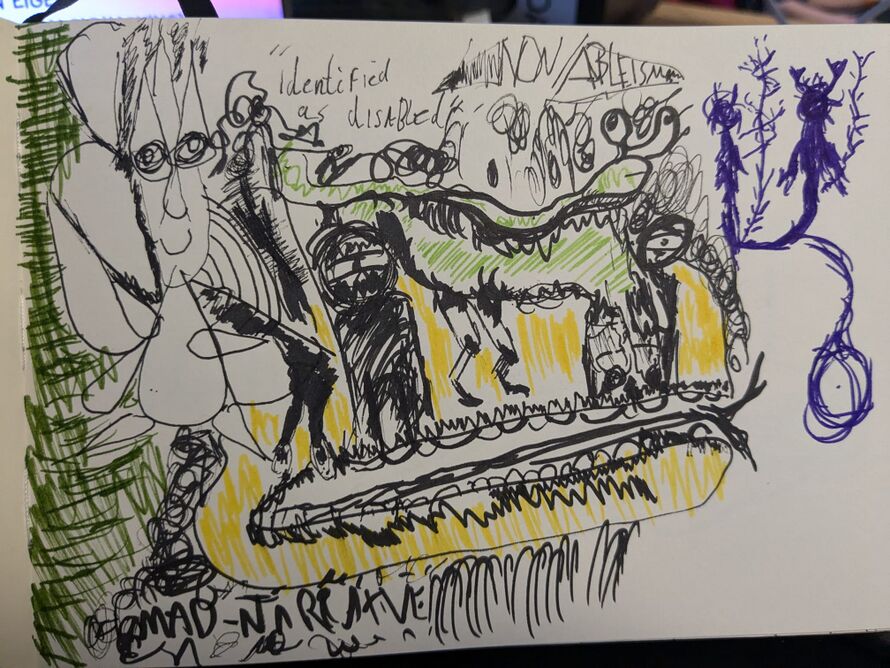
It feels like some sort of modern day privilege to identify as your condition. As a comic sketch that comes to mind, that people have learned these words from pop culture and then say to someone that can barely function because of the conditions that they have, that this new person identifies as disabled and then just goes around telling other people just how disabled they are. And to close this thought bubble of yet another frustration, a recent internet finding was that this online (self)diagnosis obsession results into a blend of popular social media trends into one. On one hand, people are getting diagnosed and the developments and benefits of it are seemingly improving as people get to get a clarification and understanding that explains why their brain works as it works. On the other hand. People are now finding out and obsessing over their newly found out diagnoses, which could cynically enough, be called a diagnose of 'recently diagnosed', what I then explain the symptoms to be as obsessed with their new findings, going online and deepdive in sicktocks[cite needed] that sometimes just consists of skits of symptoms. But also is leading to an online checklist in a video of 30 seconds which not only abuses an attention span but also miseducates because it is a fuckin spectrum to begin with. There are now collective thought streams going around, navigating symptoms based on astrology. So that the place and time where and when you are born, define your conditions. [29] And I feel that in these surroundings, these identities are being blend as a whole, while their contexts and nuances differ tremendously.
So in this case the threshold on both progressive in-fighting and conservative close families are something that does not exactly help me or us get around in our surroundings.
So from the idea of our (mother/brother/me), how do I imagine an ideal world?
In this idea I see myself living in a space with wheelchair/mobility accessible entrances so either bottom floor or elevator to my space. I see a permanent ramp at my mothers place but also at cultural spaces like Cinerama.
The services of getting around my brother and mother need to be better.
Concerning Rotterdam, I'm hoping that there is a mixed co-existence community sense without the ideas of ableism and racism and all these typical anti-isms that should be part of other isms. Cultural institutions should not think too high of themselves, people living in local poverty shouldn't give up hope. A city is a place where people live with needs, aware of the economic branches. Selling things often better than they are is a learning curve that is only taught in times of low to no income.
How can we build a city accustom to the needs? The image of a city that cares isn't something bad. But also it is not bad to look and be confronted with local contexts instead of big ideological progressive or conservative whataboutisms.
The fact that I really need to show 20 drawings to make this point is a reason to believe it is not simple at all. I accept nuance and contexts and just like with nether-hell & happytalism, contextures hopefully will mean something when I walk out of Piet Zwart / Willem de Kooning / Hogeschool Rotterdam. When the contextual paradoxes of a cultural institution are printed on my Masters in Experimental Publishing. I am not sure if being an artist is the way to practice what I preach. Because I already doing so much. Without getting paid. I have a mediocre existence with a heavy role and to not get depressed in these times but try to be mindful of the absurdity of these contextures.
https://www.rijnmond.nl/nieuws/1930343/vervoerder-trevvel-spant-kort-geding-aan-tegen-gemeente-rotterdam-we-maken-ons-grote-zorgen
https://www.government.nl/topics/care-and-support-at-home/social-support-act-wmo
https://www.rotterdam.nl/wonen-leven/vraagwijzer
https://www.trevvel.nl/trevvel-sociaal/uit-thuis-agenda/
https://www.verwijswijzer.nl/rotterdam/hulpmiddelen-en-aanpassingen/aanvullend-openbaar-vervoer.html
https://openrotterdam.nl/directeur-miniworld-woest-nadat-senior-klant-drie-uur-moet-wachten-op-taxi/
https://www.rijksoverheid.nl/onderwerpen/zorg-en-ondersteuning-thuis/wmo-2015
https://www.trevvel.nl/doelgroepenvervoer/trevvel-samen/
https://www.government.nl/topics/care-and-support-at-home/social-support-act-wmo
https://www.rotterdam.nl/wonen-leven/vraagwijzer
https://www.trevvel.nl/trevvel-sociaal/uit-thuis-agenda/
https://www.verwijswijzer.nl/rotterdam/hulpmiddelen-en-aanpassingen/aanvullend-openbaar-vervoer.html
https://openrotterdam.nl/directeur-miniworld-woest-nadat-senior-klant-drie-uur-moet-wachten-op-taxi/
https://www.rijksoverheid.nl/onderwerpen/zorg-en-ondersteuning-thuis/wmo-2015
https://www.trevvel.nl/doelgroepenvervoer/trevvel-samen/
- ↑ an infrastructure for counter-mapping / anti-campaigning by showing (human) complications
- ↑ Unity3D, Cinema4D, Unreal Engine
- ↑ Jump up to: 3.0 3.1 "PDD-NOS stands for Pervasive Developmental Disorder-Not Otherwise Specified. PDD-NOS was one of several previously separate subtypes of autism that were folded into the single diagnosis of autism spectrum disorder (ASD) with the publication of the DSM-5 diagnostic manual in 2013. In the past, psychologists and psychiatrists often used the term “pervasive developmental disorders” and “autism spectrum disorders” (ASD) interchangeably. As such, PDD-NOS became the diagnosis applied to children or adults who are on the autism spectrum but do not fully meet the criteria for another ASD such as autistic disorder (sometimes called “classic” autism) or Asperger syndrome. Like all forms of autism, PDD-NOS can occur in conjunction with a wide spectrum of intellectual ability. Its defining features are significant challenges in social and language development. Some developmental health professionals refer to PDD-NOS as “subthreshold autism." In other words, it’s the diagnosis they use for someone who has some but not all characteristics of autism or who has relatively mild symptoms. For instance, a person may have significant autism symptoms in one core area such as social deficits, but mild or no symptoms in another core area such as restricted, repetitive behaviors." https://www.autismspeaks.org/pervasive-developmental-disorder-pdd-nos
- ↑ Sotos syndrome is a genetic disorder, described in 1964, characterized by excessive growth before and after birth, a large, elongated (dolichocephalic) head, distinctive facial configuration, and a non-progressive neurological disorder with intellectual disability. Advanced bone age is present in approximately 75 to 85% of patients. https://rarediseases.org/rare-diseases/sotos-syndrome/
- ↑ https://www.bladderandbowel.org/stoma/what-is-a-stoma/
- ↑ https://www.nps.org.au/medicine-finder/olimel-emulsion-for-infusion
- ↑ https://graduation.kabk.nl/2023/lorenzo-quint
- ↑ https://www.researchcatalogue.net/view/1702786/1702785
- ↑ Manoeuvre meaning, a movement or series of moves requiring skill and care or carefully guide or manipulate someone or something in order to achieve an end.
- ↑ My mother also uses a mobility scooter because she can not walk long distances, she also has arthritis and joint pain).
- ↑ Jump up to: 11.0 11.1 A customized transport company, name is pronounced as travel but written in phonetic Dutch. https://www.trevvel.nl/over-trevvel/
- ↑ Mantelzorg means cloak care in Dutch. The term was introduced by Johannes Hattinga Verschure in 1972. It describes the system of informal social care in the Netherlands. Informal care is the care for chronically ill, disabled and needy by relatives, friends, acquaintances and neighbours.
- ↑
- ↑ Trevvel Samen is basically 'traveling together'. You can apply for Trevvel Samen if you have an illness, handicap or of an age that public transport becomes impossible to use. It is a social taxi service that picks you up and delivers you to where you need to be.
- ↑ When you are in either Wet Langdurige Zorg (Long-term care act) [4] or Wet Maatschappelijke Ondersteuning (social care act) [5] it takes longer (so to 8 weeks) to process your application. https://www.verwijswijzer.nl/rotterdam/hulpmiddelen-en-aanpassingen/aanvullend-openbaar-vervoer.html
- ↑ (Fill in a form, call 14010 or visit a location.) https://www.rotterdam.nl/en/contact
- ↑ Jump up to: 17.0 17.1 Vierde Nota Ruimtelijke Ordening Extra"; Fourth Memorandum on Extra Spatial Planning (src will be added)
- ↑ https://www.stationbergweg.nl/
- ↑ https://youtu.be/l-0fHhpGVg0
- ↑ https://www.instagram.com/crackcity "The REAL Rotterdam aka crack city 🚩/ Demotivation account so the tourists head back to 020 (Amsterdam), where they belong.
- ↑ https://indebuurt.nl/rotterdam/genieten-van/mysteries/sterker-door-strijd-wapen-rotterdam~87976/
- ↑ https://youtu.be/ZEGXWL4XQnM
- ↑ Rotown Magic Rotterdam is niet te filmen De beelden wisselen te snel Rotterdam heeft geen verleden en geen enkele trapgevèl Rotterdam is niet romantisch heeft geen tijd voor flauwekul is niet vatbaar voor suggesties luistert niet naar slap gelul 't Is niet camera-gevoelig lijkt niet mooier dan het is Het ligt vierkant hoog en hoekig gekanteld in het tegenlicht Rotterdam is geen illusie door de camera gewekt Rotterdam is niet te filmen Rotterdam is vééls te ècht Deelder.
- ↑ "Rotterdam is een stad met twee gezichten. Het is de stad van rouwdouwers die niet lullen maar poetsen, maar ook de stad met de grootste werkloosheid en armoede. De Hokjesman gaat op zoek naar het hart van de Rotterdammer en mengt zich onder de 170 etniciteiten die de stad rijk is. Waarom houdt de Rotterdammer zo van bouwputten en heipalen? Hoe komt het dat een Kaapverdiaanse bewoner van de stad zich zelden of nooit Nederlander noemt, maar wel Rotterdammer? In deze slotuitzending onderzoekt de Hokjesman de stad waar de schotten tussen de hokjes definitief lijken te zijn verdwenen." https://npo.nl/start/serie/de-hokjesman
- ↑ a term I coined, looking at Rotterdam only from a rendered precalculated perspective.
- ↑ harvard bla bla
- ↑ reneboersrc
- ↑ https://www.groene.nl/artikel/altijd-weer-datzellefde-koleertige-kut-amsterdam
- ↑
